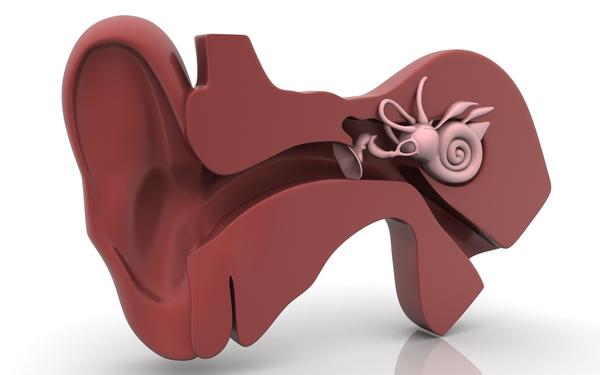One of the more notable factors affecting the field of medical 3D printing is the simple ‘cool’ factor in looking at how far we have come from treatments of times long past. A common ailment, requiring medical attention through the ages, has been a perforated eardrum, which can occur due to trauma, infection, or Q-Tips.
In 1640, for example, Marcus Banzer attempted to repair a perforated eardrum utilizing an ivory tube covered by pig’s bladder. While pig parts gave way eventually to more modern methods using autografts and homografts taken from, respectively, a patient’s own or a donor’s tissue, these repairs are still not exactly ideal for perforations that do not heal naturally.
From pig’s bladder to human tissue grafting techniques, scaffolding has long been shown to be an effective method to lessen the need for reconstructive surgical procedures (myringoplasty), encouraging the growth of the collagen fibers that form the tympanic membrane (TM, or eardrum), which separates the external and middle sections of the human ear.
A paper published today, May 7, in Biofabrication IOP Publishing, presents the latest in advanced research regarding eardrum reconstruction. The research team, hailing from Italy and the Netherlands, collaborated to produce the paper, titled “Multiscale fabrication of biomimetic scaffolds for tympanic membrane tissue engineering.”
The researchers’ academic affiliations include the University of Pisa (Italy), University of Twente (Netherlands), Maastricht University (Netherlands), and the Biorobotics Institute, Scuola Superiore Sant’Anna, Pontedera (Italy).
“Since the eardrum is a unique tissue in the human body,” researcher Dr. Serena Danti of the University of Pisa noted, “traditional replacements are usually autografts that have come from other tissues which do not have specific structural similarity with the eardrum. Consequently, their acoustic performances are not optimal.”
Two different techniques were examined in the course of the research conducted, both creating scaffolds using FDA-approved copolymers designed to host cellular growth. These scaffolds were similar in size to natural eardrums, designed to have a 15mm diameter and 100µm thickness.
 The first technique utilized electrospinning (ES) fine fibers PLGA (polylactic-co-glycolic acid) in producing a one-dimensional scaffold structure. The second brought this electrospinning technique together with 3D printing (additive manufacturing, or AM).
The first technique utilized electrospinning (ES) fine fibers PLGA (polylactic-co-glycolic acid) in producing a one-dimensional scaffold structure. The second brought this electrospinning technique together with 3D printing (additive manufacturing, or AM).
In the second technique, two- and three-dimensional structures were produced through the use of radial and circular patterned PEOT/PBT, and these were shown to be the most effective in cultivating growth. As described in the study’s abstract:
“…Dual and triple scale scaffolds were fabricated combining conventional ES with AM to produce poly(ethylene oxide terephthalate)/poly(butylene terephthalate) block copolymer scaffolds with anatomic-like architecture. The processing parameters were optimized for each manufacturing method and copolymer. TM scaffolds were cultured in vitro with human mesenchymal stromal cells, which were viable, metabolically active and organized following the anisotropic character of the scaffolds. The highest viability, cell density and protein content were detected in dual and triple scale scaffolds.”
That is, all of the produced scaffolds saw the desired growth–with the best results achieved through the use of additive manufacturing technology. 3D printing has thus proven itself as a viable method of combining with electrospinning.
“The eardrum has a complex structure with collagen fibres arranged precisely to interact with sound waves,” Dr. Danti explained. “We have replicated this structure in our scaffolds by combining electrospinning with 3D fibre deposition, and we believe this will eventually allow for replacements that are anatomically and acoustically similar to the eardrum.”
This research provides a fertile foundation on which to build as the medical community continues to seek the best means of repair for a delicate area. Let us know what you think about this latest research in the 3D Printed Eardrum Scaffolding forum thread over at 3DPB.com
Subscribe to Our Email Newsletter
Stay up-to-date on all the latest news from the 3D printing industry and receive information and offers from third party vendors.
You May Also Like
3D Printing Unpeeled: New Arkema Material for HP, Saddle and Macro MEMS
A new Arkema material for MJF is said to reduce costs per part by up to 25% and have an 85% reusability ratio. HP 3D HR PA 12 S has been...
3D Printing News Briefs, January 20, 2024: FDM, LPBF, Underwater 3D Printer, Racing, & More
We’re starting off with a process certification in today’s 3D Printing News Briefs, and then moving on to research about solute trapping, laser powder bed fusion, and then moving on...
3D Printing Webinar and Event Roundup: December 3, 2023
We’ve got plenty of events and webinars coming up for you this week! Quickparts is having a Manufacturing Roadshow, America Makes is holding a Member Town Hall, Stratafest makes two...
Formnext 2023 Day Three: Slam Dunk
I’m high—high on trade show. I’ve met numerous new faces and reconnected with old friends, creating an absolutely wonderful atmosphere. The excitement is palpable over several emerging developments. The high...
































